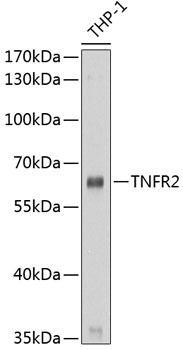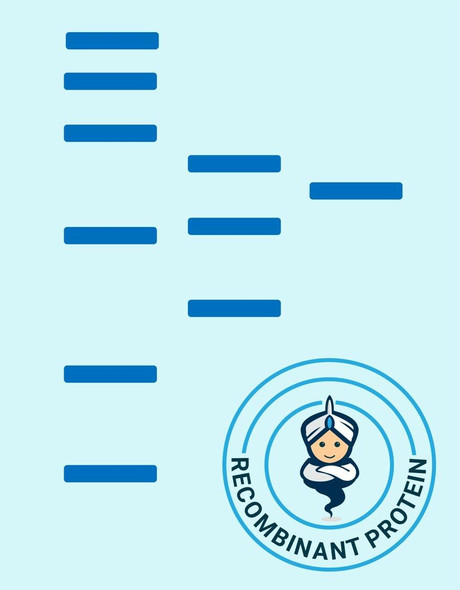Cell Death Antibodies 1
Anti-TNFR2 Antibody (CAB1095)
- SKU:
- CAB1095
- Product Type:
- Antibody
- Reactivity:
- Human
- Reactivity:
- Mouse
- Reactivity:
- Rat
- Host Species:
- Rabbit
- Isotype:
- IgG
- Antibody Type:
- Polyclonal Antibody
- Research Area:
- Cell Death
Description
| Antibody Name: | Anti-TNFR2 Antibody |
| Antibody SKU: | CAB1095 |
| Antibody Size: | 20uL, 50uL, 100uL |
| Application: | WB |
| Reactivity: | Human, Mouse, Rat |
| Host Species: | Rabbit |
| Immunogen: | A synthetic peptide of human TNFRSF1B |
| Application: | WB |
| Recommended Dilution: | WB 1:500 - 1:2000 |
| Reactivity: | Human, Mouse, Rat |
| Positive Samples: | THP-1 |
| Immunogen: | A synthetic peptide of human TNFRSF1B |
| Purification Method: | Affinity purification |
| Storage Buffer: | Store at -20'C. Avoid freeze / thaw cycles. Buffer: PBS with 0.02% sodium azide, 50% glycerol, pH7.3. |
| Isotype: | IgG |
| Sequence: | Email for sequence |
| Gene ID: | 7133 |
| Uniprot: | P20333 |
| Cellular Location: | Cell membrane, Secreted, Single-pass type I membrane protein |
| Calculated MW: | 28kDa/48kDa |
| Observed MW: | 64kDa |
| Synonyms: | CD120b, TBPII, TNF-R-II, TNF-R75, TNFBR, TNFR1B, TNFR2, TNFR80, p75, p75TNFR, TNF Receptor II, TNFRSF1B |
| Background: | The protein encoded by this gene is a member of the TNF-receptor superfamily. This protein and TNF-receptor 1 form a heterocomplex that mediates the recruitment of two anti-apoptotic proteins, c-IAP1 and c-IAP2, which possess E3 ubiquitin ligase activity. The function of IAPs in TNF-receptor signalling is unknown, however, c-IAP1 is thought to potentiate TNF-induced apoptosis by the ubiquitination and degradation of TNF-receptor-associated factor 2, which mediates anti-apoptotic signals. Knockout studies in mice also suggest a role of this protein in protecting neurons from apoptosis by stimulating antioxidative pathways. |
| UniProt Protein Function: | TNF-R2: Receptor with high affinity for TNFSF2/TNF-alpha and approximately 5-fold lower affinity for homotrimeric TNFSF1/lymphotoxin-alpha. The TRAF1/TRAF2 complex recruits the apoptotic suppressors BIRC2 and BIRC3 to TNFRSF1B/TNFR2. This receptor mediates most of the metabolic effects of TNF-alpha. Isoform 2 blocks TNF-alpha-induced apoptosis, which suggests that it regulates TNF-alpha function by antagonizing its biological activity. Binds to TRAF2. Interacts with BMX. 2 isoforms of the human protein are produced by alternative splicing. |
| UniProt Protein Details: | Protein type:Membrane protein, integral; Receptor, cytokine Chromosomal Location of Human Ortholog: 1p36.22 Cellular Component: cell soma; perinuclear region of cytoplasm; integral to membrane; plasma membrane; extracellular region; nucleus; lipid raft Molecular Function:protein binding; tumor necrosis factor receptor activity; ubiquitin protein ligase binding Biological Process: tumor necrosis factor-mediated signaling pathway; DNA damage response, signal transduction resulting in induction of apoptosis; negative regulation of inflammatory response; immune response; RNA destabilization; inflammatory response; positive regulation of membrane protein ectodomain proteolysis; aging |
| NCBI Summary: | The protein encoded by this gene is a member of the TNF-receptor superfamily. This protein and TNF-receptor 1 form a heterocomplex that mediates the recruitment of two anti-apoptotic proteins, c-IAP1 and c-IAP2, which possess E3 ubiquitin ligase activity. The function of IAPs in TNF-receptor signalling is unknown, however, c-IAP1 is thought to potentiate TNF-induced apoptosis by the ubiquitination and degradation of TNF-receptor-associated factor 2, which mediates anti-apoptotic signals. Knockout studies in mice also suggest a role of this protein in protecting neurons from apoptosis by stimulating antioxidative pathways. [provided by RefSeq, Jul 2008] |
| UniProt Code: | P20333 |
| NCBI GenInfo Identifier: | 21264534 |
| NCBI Gene ID: | 7133 |
| NCBI Accession: | P20333.3 |
| UniProt Secondary Accession: | P20333,Q16042, Q6YI29, Q9UIH1, B1AJZ3, |
| UniProt Related Accession: | P20333 |
| Molecular Weight: | 28,461 Da |
| NCBI Full Name: | Tumor necrosis factor receptor superfamily member 1B |
| NCBI Synonym Full Names: | tumor necrosis factor receptor superfamily, member 1B |
| NCBI Official Symbol: | TNFRSF1B |
| NCBI Official Synonym Symbols: | p75; TBPII; TNFBR; TNFR2; CD120b; TNFR1B; TNFR80; TNF-R75; p75TNFR; TNF-R-II |
| NCBI Protein Information: | tumor necrosis factor receptor superfamily member 1B; TNF-R2; TNF-RII; p75 TNF receptor; p80 TNF-alpha receptor; soluble TNFR1B variant 1; tumor necrosis factor receptor 2; tumor necrosis factor beta receptor; tumor necrosis factor receptor type II; tumor necrosis factor binding protein 2 |
| UniProt Protein Name: | Tumor necrosis factor receptor superfamily member 1B |
| UniProt Synonym Protein Names: | Tumor necrosis factor receptor 2; TNF-R2; Tumor necrosis factor receptor type II; TNF-RII; TNFR-II; p75; p80 TNF-alpha receptor; CD_antigen: CD120b; INN: EtanerceptCleaved into the following 2 chains:Tumor necrosis factor receptor superfamily member 1b, membrane form; Tumor necrosis factor-binding protein 2Alternative name(s):TBP-2; TBPII |
| UniProt Gene Name: | TNFRSF1B |
| UniProt Entry Name: | TNR1B_HUMAN |
View AllClose







